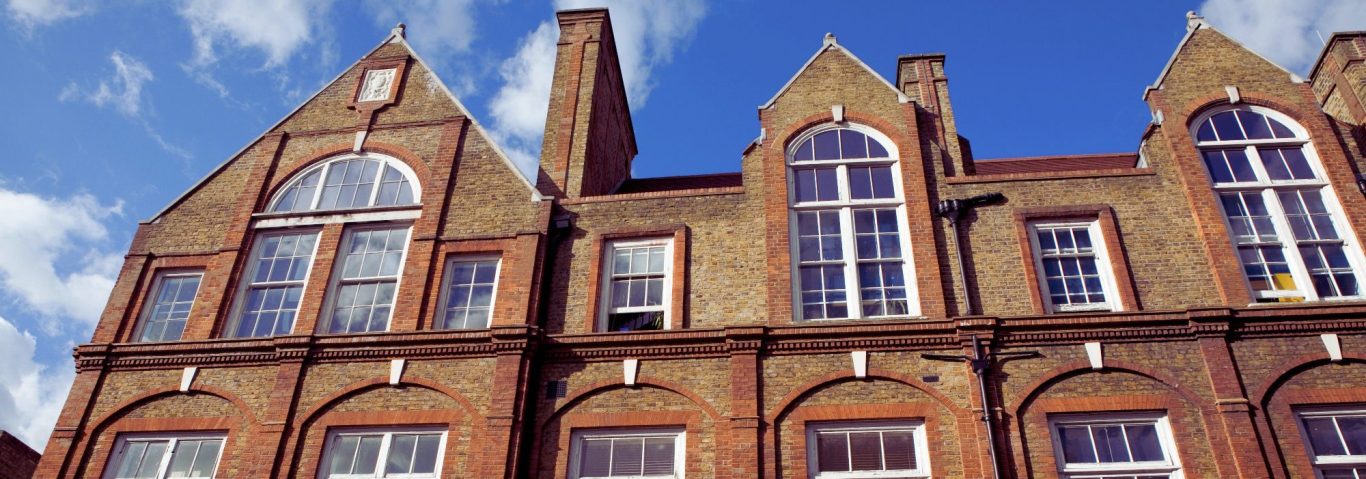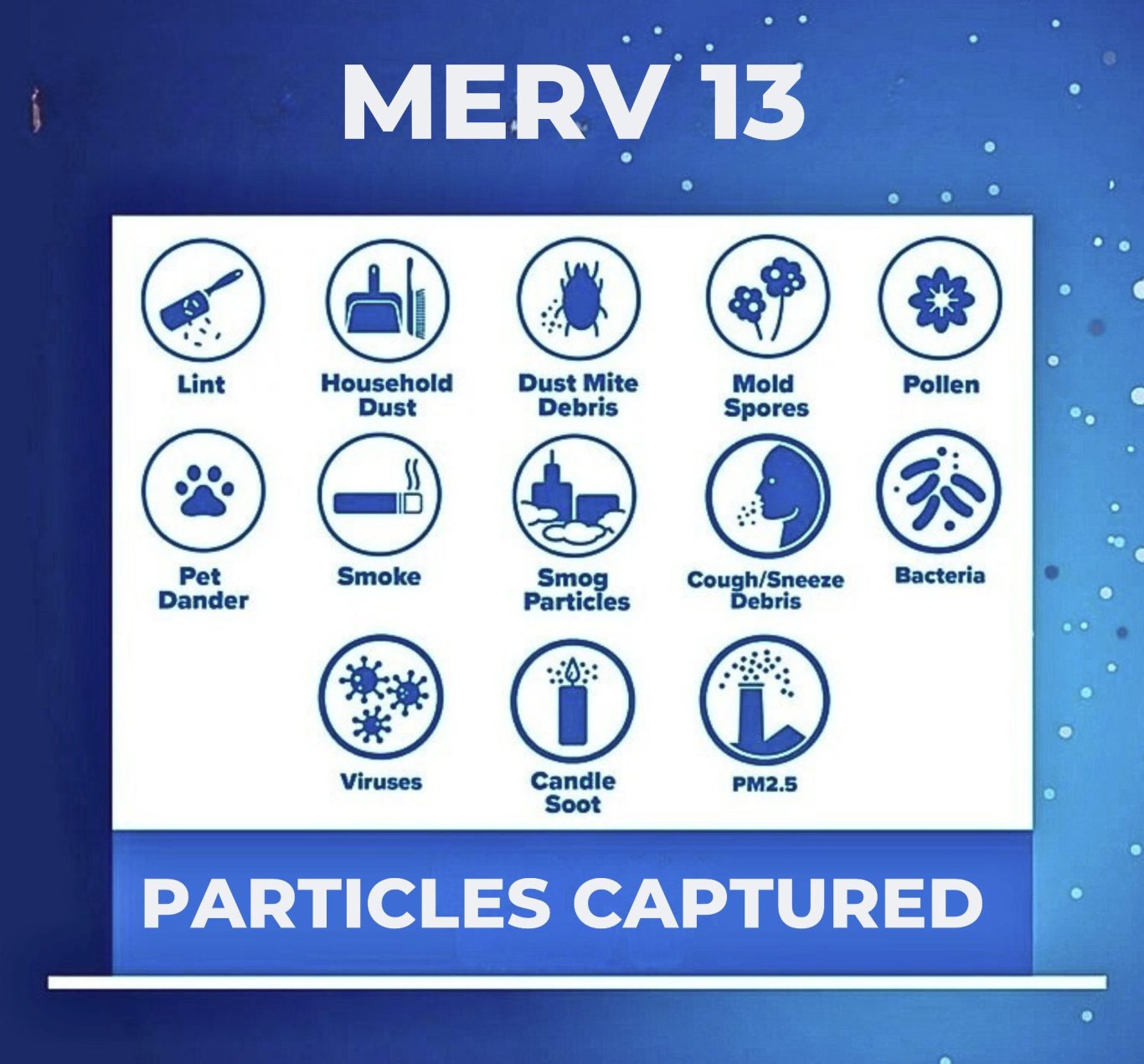What Can We Do to Improve Air Quality in Schools?

Millions of children across the UK and Northern Ireland study in school buildings that require significant building repairs. Due to poor air quality inside classrooms, refurbishment should include upgrades to mechanical ventilation with heat recovery (MVHR) systems. This requires time and government investment.
What can we do right now?
Ventilation
Simple interventions can improve indoor air quality. Ventilation is the process of supplying fresh air into indoor spaces while removing polluted and stale air. It is a key controlling factor for indoor air quality because it dilutes and blows away pollutants such as virus particles and airborne allergens that build up inside. For example, when someone with a respiratory infection breathes, speaks, coughs or sneezes they release particles small enough to float in the air (aerosols). These can be breathed in by someone else, which spreads the disease. Good ventilation helps to remove these particles. There are several types of ventilation systems:
Natural ventilation is driven by wind and differences in temperature. Openings like windows, doors and vents allow air to flow into a building and stale air to exit.
Mechanical ventilation involves mechanical systems such as fans and ducts to drive the flow of air in and out of a building.
Most UK state schools rely exclusively on natural ventilation but a quarter of UK pupils attend schools where air pollution is over the limit set by the World Health Organisation. Opening windows can simply flood classrooms with outdoor air pollution. For other UK state schools, there are no windows, windows are broken or sealed shut. The cold and wet winter months can make natural ventilation unappealing or lead to lost energy through open windows. Despite all these challenges there are ways to maximise natural ventilation. Useful guides include Good Ventilation In Schools and How To Achieve It: a guide by five unions, and: Attendance Focus Shows Why Good Ventilation In Schools Still Matters: a TES article by Professor Cath Noakes and Dr Henry Burridge.
Benefits of Good Ventilation
Reduced risk of respiratory illnesses and allergic reactions such as asthma by removing large particles and dust and preventing the build-up of mould.
Reduced risk of spreading and catching diseases such as flu and COVID-19
Improved mental health and sleep
Less illness and fewer related absences for staff and students
Improved productivity and concentration of staff and students
Reduced asthma symptoms
Improved cognitive function and test scores
Warning Signs of Bad Ventilation
The air feels stuffy or the room feels too hot
The air smells unpleasant and is not dissipating
The room feels muggy or there is any condensation or damp
There is any mould growth
Alerts by CO2 monitors
Air Filtration
For cases where natural ventilation is inadequate, or there is outdoor pollution (especially particulate matter PM2.5 from traffic), complementary technologies are needed. Filtration is an effective alternate way of removing exhaled aerosol from a room, as well as pollen, PM2.5 from traffic, dust, smoke, and many other types of pollution from indoor and outdoor sources. While this can be delivered by mechanical ventilation systems (a preferred long-term solution), portable air cleaners are a low-cost technology that can deliver short and medium term benefits.
Why Does CO₂ Matter?

Carbon dioxide (CO₂) is a naturally occurring gas we exhale when we breathe out. CO₂ levels are therefore used to assess indoor ventilation. The Department for Education (DfE) has provided all schools with a CO₂ monitor and advised that they should be used consistently and regularly to identify when ventilation needs improvement. Implementing the monitors has been problematic, training has been sparse and compliance has been poor. In reality, many CO₂ monitors are unused.
Carbon Dioxide (CO₂) monitors inform us how much of the air we breathe in has been breathed out by others. The concentration of CO₂ is measured in parts per million (ppm). The CO₂ level outdoors is around 415ppm. Poor ventilation can lead to a build-up of CO₂ indoors; if CO₂ levels are high (1 000ppm and above), a high proportion (>1.5%) of the air is exhaled breath; and if an infected person is present, there may also be a high concentration of airborne virus, and therefore a high risk of infecting others. Guidelines state that CO₂ levels of indoor air are healthy and satisfactory up to 800ppm. This level can be achieved with natural ventilation in some classrooms, but is difficult to achieve in others because classrooms are up to four times more densely populated than office spaces.
"CO2 levels will be constantly changing so you should
check the monitor regularly"
Department for Education
Ideally, each naturally ventilated classroom needs a CO₂ monitor on display to check ventilation levels in real time. This is because natural ventilation delivered by open windows varies dramatically depending on the weather. It is also more efficient when it is colder outside. So in winter, it may be that a classroom is very well ventilated even without fully opening all windows; or by refreshing the air for a few minutes every half hour or so. CO2 monitors help manage the balance between comfort/heating costs, and good ventilation.
For how to use a CO2 monitor download this comprehensive poster from the National Education Union. For alternative sources for information visit the Health And Safety Executive or the Department for Education.
Ventilation Guidelines
Individual settings are responsible for maintaining adequate ventilation. The DfE and unions have given schools guidance on ventilation and air filters. There are no requirements to routinely monitor air quality inside schools, or mechanisms to enforce current guidelines. Often, classrooms don't meet guidance.
The British Council for Offices has updated its ventilation standards. Recommended CO₂ levels have been reduced to 800ppm. This is in line with REHEVA recommendations of 600-800ppm for reliable indoor air quality. The Scientific Advisory Group for Emergencies similarly recommends CO₂ levels below 800ppm. The DfE however, hasn’t updated its 2018 guidance for schools to match it. Further, the DFE guidance states “that the maximum concentration should also not exceed 2000ppm for more than 20 consecutive minutes each day when the number of room occupants is equal to, or less than the design occupancy”.
The HSE state that CO2 levels consistently higher than 1500ppm in an occupied room indicate poor ventilation and action should be taken to improve it. As the concentration of CO₂ in air rises beyond 1000ppm it can cause headaches, dizziness and other symptoms. Ventilation needs improving.
It is crucial to update and enforce guidelines. It is time for health-based rather than minimum indoor air quality standards in our schools
We need to update and enforce guidelines to enhance existing school buildings and ensure new investments in school infrastructure prioritise indoor air quality. In Ireland, The Health & Safety Authority (HSA) has issued a new Code of Practice for Indoor Air Quality (IAQ). Under this guidance, which has been signed into law, all classrooms and workplaces should consistently maintain CO₂ levels under 1 000ppm. If this cannot be achieved with natural ventilation alone, air filters should be installed to remove harmful contaminants. The new Code is available to assist employers with managing IAQ in the workplace. The rest of the UK must do the same.

*These graphs are examples of CO₂ levels in UK Secondary School classrooms. On the left we see that CO₂ levels are higher in school than outside of school. On the right we see that when pupils enter school in the morning, CO₂ immediately rises beyond the recommended 800ppm. It fluctuates as pupils move between different classrooms for lessons, staying above 1500ppm for much of the day. It drops at 3.30 pm because the monitor is removed from the school when pupils went home.
What Is A Portable Air Cleaner?

"We know [air filters] work, so use them where there are infection risks and ventilation is not sufficient."
Professor Catherine Noakes OBE
Environmental Engineering for Buildings at the University of Leeds
Portable air cleaners (also known as “air purifiers” or "air filters") use a technology called HEPA (high efficiency particulate air) [filter] to filter the air. They are plug in portable boxes that suck air in at the sides and blow filtered air out, usually from the top. It is a basic yet effective concept developed in World War II to filter radiation. They use very little power, some using less energy than a light bulb. Portable air filters should be used in addition to natural ventilation because they do not reduce CO2 levels or affect the humidity of a room.
The portable air cleaner market is badly regulated open to marketing misinformation and bold claims that can confuse consumers. It is therefore difficult to compare machines. Experts state that manufacturers should be clear about a machine's performance; added technology should be proven effective, published and peer reviewed while terminology and standards should be clear and consistent globally.
The TAPAS network (Tackling Air Pollution At Schools) recommends introducing an accredited organisation to ensure objective assurance of the safety and efficacy of devices, in realistic environments considering both biological and chemical pollutants. They are a network comprising of stakeholders across academia, education, public policy, civil society and business. They work together to support the development of healthy schools by improving air quality.
There are many types of air cleaners varying in price, performance and function. Some of the most important things to consider when looking to purchase are:
1. The size of the classroom
An average classroom is 55m2.
2. The problem
For schools, the main problems are PM2.5 and biological contaminants like viruses.
3. Requirements
Air Changes Per Hour
The World Health Organisation recommends SIX Air Changes Per Hour (ACH) for schools. Air Changes Per Hour means the number of times that the air in a room is completely removed and replaced in an hour. With air filtration, the air is cleaned rather than removed so the term used is equivalent Air Changes Per Hour (eACH).
Air flow
Ventilation is measured in litres per second per person in the space. Many experts including the World Health Organisation recommend a minimum of 10 litres per second per person.
Noise
Maintaining noise levels in classrooms below 40-45 decibels is recommended.
Available Space
UK classes typically comprise 30 students and space is in short supply. Some units require placement in the centre of a room or raised from the floor. Some spaces will require more than one air filter. Experts state that having several air filters spaced around a room provides more effective filtration than a single filter.
Available Plug Sockets
More than one filter may be required per class, requiring sufficient plug sockets.
Replacement Filters
Filters will need replacing and periodically cleaning. The price of each filter, how quickly and practically it is to replace and source them are all important considerations for schools. Manufacturer's recommendations on maintenance and replacement should be followed.
Carbon Filter
Some machines have this as standard or offer this as an option. It removes gaseous contaminants from the air that the HEPA filter cannot. It isn't needed to mitigate against viruses.
4. Air Cleaner Efficiency
Not all air purifiers are created equal. This is where Clean Air Delivery Rate (CADR) comes in. CADR is an industry-standard measure. It is a crucial metric because it provides consumers with a reliable way to compare one unit with another. CADR measures the total volume of clean air the purifier produces per minute and is measured in cubic feet per minute (CFM) - essentially how powerful it is.
A higher CADR rating means that the air purifier can clean the air faster, making it more efficient. On the other hand, an air purifier with a low CADR rating may not be as effective in removing pollutants from the air, leaving children and staff breathing in harmful particles.
So when choosing an air purifier for a classroom, you must ensure that the CADR of the device is enough to purify the air 6 times per hour. More than one air purifier may be necessary to achieve the recommended safety and efficiency standards.
CADR is not the only factor to consider when purchasing an air purifier. Other factors include filter type and replacement costs.
5. Cost, Misleading Claims And Hidden Extras
The market is poorly regulated, facilitating bold claims and marketing misinformation. Experts state that manufacturers must align to show certified CADR, noise and power at different speeds.
CADR per £pound allows machines to be compared. However, if CADR per £ is good but the air cleaner is noisy at high fan speeds, teachers will turn the machine off.
Built-in technology and gadgets can elevate prices with limited benefit. Similarly, air filters alone are usually best. Built in technology has the potential to add substances to the air and change the air chemistry.
6. Type of Air Filter
There are lots of different types of filters. MERV 13 HEPA filters are a great choice for classrooms. HEPA stands for High-Efficiency Particulate Air filters. This filter can remove at least 99.97% of allergens and pollutants. MERV means Minimum Efficiency Reporting Value. This helps compare the performance of different filter's ability to capture particles between 0.3 and 10 microns (µm). The higher the MERV rating the better the filter is at trapping specific types of particles.
Activated carbon filters are another type of filter. This one uses activated charcoal to clear odours, chemicals and smoke from the air. They need to be replaced frequently and don't filter allergens or bacteria but can be an added extra if required. Other filter options include ionic, ultraviolet and ozone filters. See the note regarding these in the Other Strategies section below.

How To Choose An Air Filter

1. Calculate the classroom dimensions. To find the overall room volume multiply height by width by length.
2. Check the filter's Clean Air Delivery Rate.
3. Check the noise level of the filter on different settings.
4. Choose the number of filters appropriate to the classroom.
5. Remember to check the size of the portable air cleaner and the number of plug sockets available for use because these will affect how many filters can be run.
For assistance in working out how many air filters are required in your classroom, visit the Clean Air Stars website.
Benefits of Safer Air
We wouldn't let our children drink dirty water, why are we letting them breathe dirty air?

Results from around the world show that ventilation and air filtration reduce air pollution including airborne pathogens. At the first WHO Europe Indoor Air Conference (2024), Cath Noakes, professor of environmental engineering in Leeds, shared the results of a randomised controlled trial in England — classrooms with air filters had 20% fewer school absences than those without. Similarly, in daycare centres air filters cut children's sick days by a third while reducing illnesses and absences among children and staff. More infections in poorly ventilated classrooms were the findings of a recent Swiss study of 150 classrooms. More than 60% had CO2 levels double >2,000ppm, and those with higher levels were significantly more likely to report outbreaks. Other findings include:
Improved test scores in maths, reading and science
Reduced absenteeism
Improved focus and concentration
Reduced frequency of respiratory illness
Reduced frequency of allergies
Reduced asthma symptoms
Higher scores on cognitive function tests
Improved comfort, reduced stress and enhanced well-being
Increased energy and alertness
Positive impact on mental health
Reduced risk of chronic disease
Reduced teacher illness absence, respiratory symptoms and improved morale
Other Strategies For Improving The Quality of Air Inside Classrooms

Source Control
Presenteeism
Discourage attendance when sick
Air Quality Surrounding Schools
Utilise Outdoor Learning Where Air Quality Allows
Education Buildings
Maintenance and improvement of school buildings and infrastructures such as doors, windows and furniture
Green Infrastructure
Use of green infrastructure such as hedges, green screens and plants
Active Travel
Using less polluted routes and to limit children's exposure while commuting
Avoid added chemistry and ionisers
Bipolar ionisation, plasma systems, portable air-cleaning units with ionisers or UV, dry hydrogen peroxide and photocatalytic oxidation are considered less cost-effective or scientifically defensible due to their unproven efficacies and their potential for degrading the quality of the air through the generation of harmful secondary pollutants.
The Ontario Society of Professional Engineers state "Avoid additive air cleaning and alternative methods. Do not use additive air cleaning methods, or similar products such as ionisation, until there is a standardised way to ensure their safety and effectiveness".
A joint union guide for union reps/health and safety reps named "Good Ventilation In Schools And How to Achieve It", states "filtration using HEPA filters is recommended, but other systems using ozone, chemicals or low-level ultraviolet-C (UVC) and calling themselves ionisers/purifiers are not advised and may carry risk or low-level irritating ozone, harmful VOC's and low-level exposure to UVC harm. They are less likely to be effective and are not regulated.
Information on this website is for informational purposes only. Safe Air Schools UK neither affiliates with nor endorses any specific product or brand.
©2025 by Safe Air Schools UK CIC | Company Number: 16405838 | Registered in England and Wales | All rights reserved | Privacy & Legal
We need your consent to load the translations
We use a third-party service to translate the website content that may collect data about your activity. Please review the details in the privacy policy and accept the service to view the translations.







